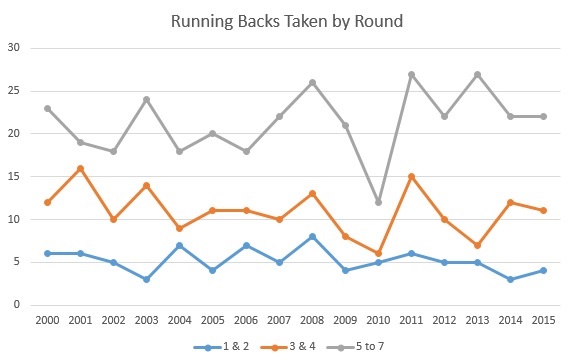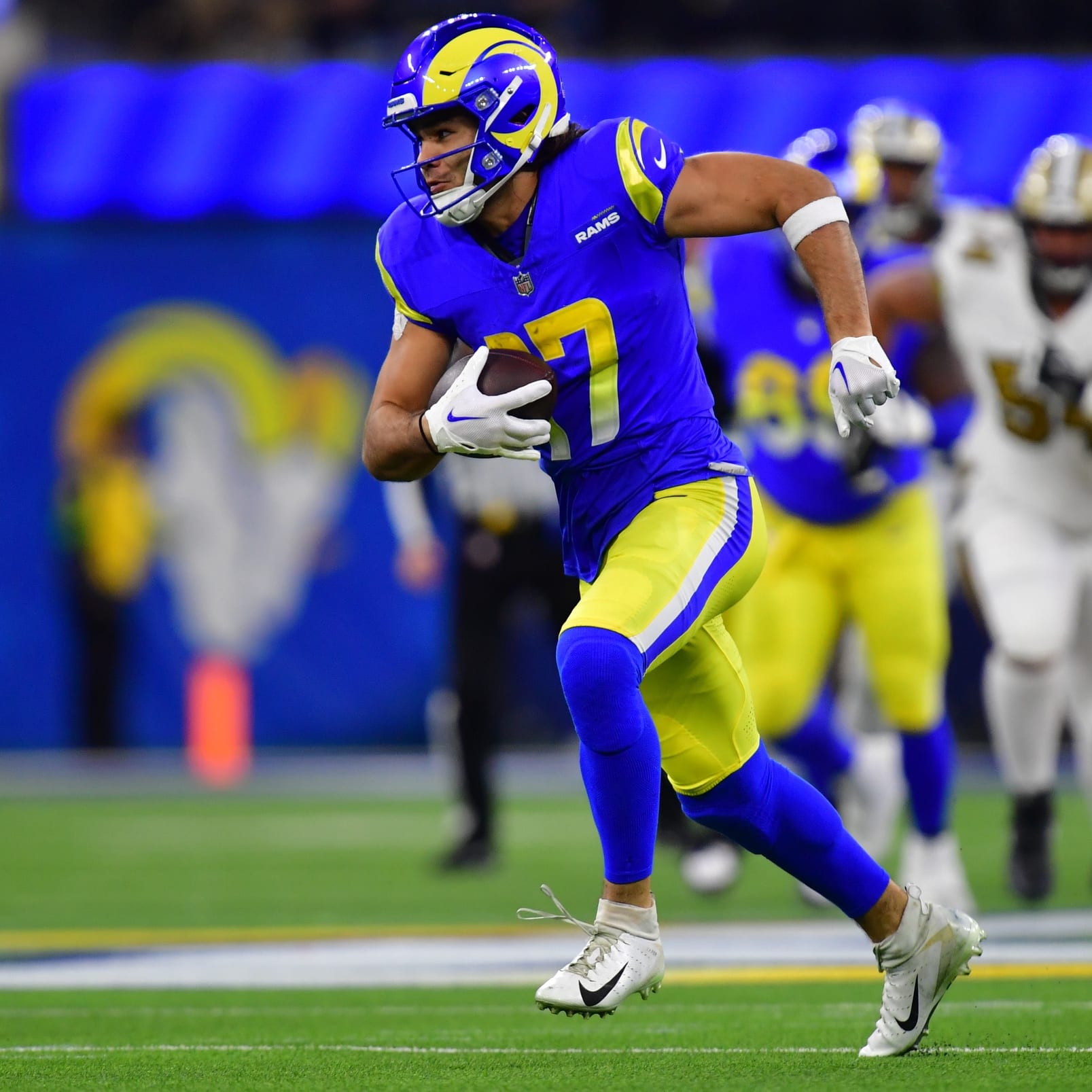This article is part of our The Stats Room series.
Well, the draft was a month or so ago and besides a few free agents, teams have their rosters set for next season. Each team got a boost of talent from the draft and most of these shiny new toys will be expected to produce, especially some fresh running backs. The Cowboys used the fourth overall pick to land Ohio State's Ezekiel Elliott with the next running back not taken until the mid-second round with the Titans picking Alabama's Derrick Henry.
Are running backs selected early in the draft more productive than those taken later?
The following is a look at how the average running back has been used and performed in his rookie season compared to the round in which he was drafted.
Teams usually base their decision to draft a player on two factors: talent and need. A running back's perceived talent is reflected in his draft stock. The lower the pick, the less is expected from the running back. The higher the pick, the better the running back will perform, hopefully. A point should exist, though, where the difference in talent is almost non-existent.
Besides drafting on talent, teams have holes to fill, which a running back
Well, the draft was a month or so ago and besides a few free agents, teams have their rosters set for next season. Each team got a boost of talent from the draft and most of these shiny new toys will be expected to produce, especially some fresh running backs. The Cowboys used the fourth overall pick to land Ohio State's Ezekiel Elliott with the next running back not taken until the mid-second round with the Titans picking Alabama's Derrick Henry.
Are running backs selected early in the draft more productive than those taken later?
The following is a look at how the average running back has been used and performed in his rookie season compared to the round in which he was drafted.
Teams usually base their decision to draft a player on two factors: talent and need. A running back's perceived talent is reflected in his draft stock. The lower the pick, the less is expected from the running back. The higher the pick, the better the running back will perform, hopefully. A point should exist, though, where the difference in talent is almost non-existent.
Besides drafting on talent, teams have holes to fill, which a running back could fill. When looking at rookie running backs, both the playing time opportunity and production need to be accounted for.
To start with, I will find which drafted running backs prove to be most productive per carry. Here are their average yards per carry grouped by round.
Note: In my database, I have only the overall pick for the player, so for each "round," I grouped the first six rounds into 32 picks with the rest of the picks getting lumped in the "7+" category.
| RND | YPC |
| 1 | 4.2 |
| 2 | 4.1 |
| 3 | 4.2 |
| 4 | 4.0 |
| 5 | 3.8 |
| 6 | 4.3 |
| 7+ | 4.0 |
The production level per carry is just not that different from the early to the late-round picks. Teams, besides the Cowboys, have noticed this trend the last four seasons because only three running backs have been taken in the first round. Teams still need running backs, but now with a sliding pay scale, why should a team waste a high pick and the money on a player who is likely to get injured (see Ki-Jana Carter). Below is graph of running backs taken by round over the years.

As shown, teams still draft running backs early with an average of about five being taken in the first two round over the years.
Now that we know that all running backs, if given the opportunity, will produce equally, which are most likely to have a great season? Here is a breakdown of the chances for total season rushing yards for these rookies.
| RND | 1,000+ YARDS | 500+ YARDS | 1 YARD |
| 1 | 17.7% | 43.5% | 64.5% |
| 2 | 7.8% | 29.7% | 60.9% |
| 3 | 1.6% | 20.3% | 64.1% |
| 4 | 1.6% | 17.5% | 66.7% |
| 5 | 0.0% | 5.6% | 66.7% |
| 6 | 3.8% | 9.4% | 60.4% |
| 7+ | 0.0% | 1.3% | 53.9% |
Starting with the first column, the only reasonable chance for a running back to get to 1,000 yards rushing is to be taken in the first couple rounds. These running backs have both perceived talent and the opportunity to have a great season.
Moving to the 500-yard rushers, anyone taken in the first four rounds has a chance to provide some production. These running backs are likely either taking over from an ineffective starter or splitting time with another running back. With the lack of 1,000-yard rushers, having a running back with some opportunity is needed, especially in deeper leagues.
Besides backs taken at the end of the draft, more than 60 percent of running backs taken in each round see some action with injuries being the main reason for the lower number. These 60-percent rates makes sense with the previous yards per carry numbers.
Running backs are all productive on the ground, but how about through the air? I will start again with the talent portion for these running backs. Here is the percentage of times they catch a pass thrown their way and the number of yards per catch.
| RND | COMP RATE | YPR |
| 1 | 74% | 8.0 |
| 2 | 74% | 7.9 |
| 3 | 73% | 8.5 |
| 4 | 71% | 8.0 |
| 5 | 72% | 7.2 |
| 6 | 73% | 7.3 |
| 7+ | 70% | 7.6 |
The completion rates have a small drop over the rounds, but these few percentage points aren't going to make a difference. Assuming six targets per game, a 1 percent drop is about one dropped target a season. Also, there might be a yards per reception spike in Round 3 because that's where pass-catching specialists like Charles Sims get taken. Teams are more willing to take the top situational backs then.
Now, there is a noticeable difference in yards per catch from the fourth to the fifth round. The lack of speed or inability to miss tackles may be the reason not many running backs are drafted after the first four rounds get used. The useful backs may need some dual-threat element.
Next, here is how often a running back will total 1,000 combined yards running and receiving.
| RND | 1,000+ COMBINED YDS | 500+ COMBINED YDS |
| 1 | 30.6% | 50.0% |
| 2 | 15.6% | 34.4% |
| 3 | 4.7% | 29.7% |
| 4 | 3.2% | 23.8% |
| 5 | 1.9% | 9.3% |
| 6 | 7.5% | 13.2% |
| 7+ | 0.0% | 3.9% |
These numbers have the same trend as the rushing-only yards, with backs who post 1,000 total yard coming from the first round. Also, it is just a 50 percent chance a first rounder will go more than 500 yards. A theme continues with the chances of 500 total yards dropping after the fourth round. If fantasy owners are considering a rookie running back, concentrate on those drafted in the first few rounds.
One final element to consider is if late-round running backs are more inclined to fumble. Teams can't have a running back who consistently fumbles. Here is the fumble rate per touch.
| RND | FUMBLE/TOUCH |
| 1 | 0.77% |
| 2 | 0.74% |
| 3 | 0.76% |
| 4 | 0.76% |
| 5 | 0.97% |
| 6 | 0.57% |
| 7+ | 1.16% |
Surprise ... well not really. All the rates are almost identical until the fifth round.
With all the preceding information on drafted running backs, two main conclusions can be drawn:
Conclusions
1. All running backs have the same general ability to rush the football, but those taken in the first four rounds are better receivers and fumble less. There's no difference in YPC between Rounds 1 and 3. So, 1,000-yard seasons are purely a function of opportunity, not skill. If a third-rounder is named the starter, he should have as many yards -- he's just less likely to be named the starter in the first place.
2. When looking for rookies to target, the 1,000-yard backs will be drafted in the first couple rounds. Additionally, few 500-yard backs are drafted after the fourth round. Target those fourth round or earlier running backs.
Well, that is all for now, for my next article, I will examine wide receivers and tight ends. As always, let me know if you have any questions.









